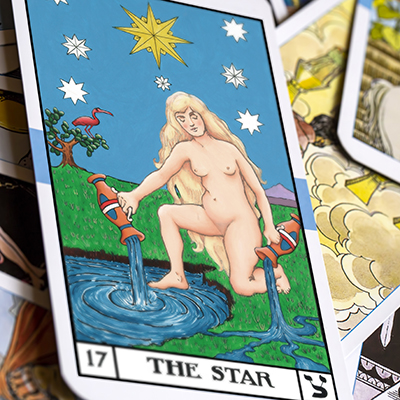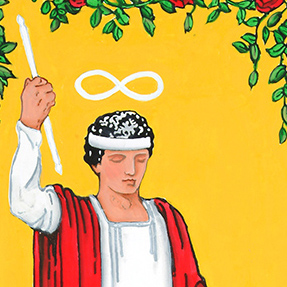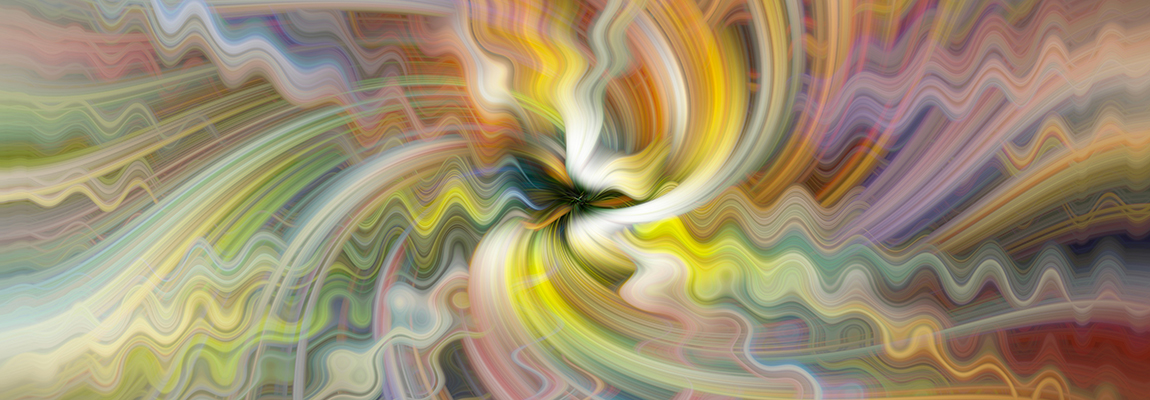From The Lantern, Summer, Fall & Winter 2000 – Reverend Ann Davies
Reprinted in the Zenith News Notes No 108, June 2015.
A Meditation Introduction
Meditation is often shrouded in mystery or confusion—many people struggle with where to begin or how to “do it right.” In this insightful article by Reverend Ann Davies, we explore a refreshingly practical and symbolic approach to meditation rooted in Tarot and Qabalah. If you’ve ever wondered whether you’re meditating—or simply worrying—you may already be closer than you think.
Common Misconceptions About Meditation
Meditation as such is something that seems to confuse many people. Tarot Key 17, called The Star, symbolises this phase of occult activity. Many of you have written to us saying, “I really do not know how to meditate,” or “I don’t know how to concentrate.” Others have said, “I don’t understand what meditation really means.” Some people think they know what it means, but do not know how to practise it properly.
When these questions arise, I always ask, “Do you know how to worry?” If you can worry – and who has filed to be a genius at worrying – then certainly you know how to concentrate. Concentration, in itself, means being focused on one thought or idea. Just focused. When you are worried, are you not focused? You try to tear your heart and mind away from the problem, but to no avail. Therefore, there is nothing wrong with your ability to keep your consciousness focused on one thing is there?
From the concentration inherent in the act of worrying, we can go to its opposite aspect. We do have those, of course, who are indiscriminately optimistic.

The Dangers of Extreme Thinking
They are so determined to be optimistic that they do not concentrate on any situation. They refuse to look at reality in the here and now. Consequently their actions are ineffective.
This refusal to really look at a situation means lack of concentration on the problems life presents to all of us. Thus they never really accomplish anything. Extremes in any direction rarely lead to good results. Within the framework of cycles we all have many, many problems. Those who refuse to look or concentrate on the situation at hand, who insist on saying, “All is going to work out all right all by itself,” usually end up in even more trouble than the ones who make a real profession out of worrying about everything. People who are in ‘hot water’ quite consistently usually follow one of these two extremes.

Tarot Key 1 The Magician and Understanding the Power of Concentration
Tarot Key 1 The Magician, is the symbolic representation of concentration. Concentration in itself is the power of attention. The power of attention is focusing on one particular something. It could be a thought, an action, a condition or an object. When we are anticipating, whether it is something happy or not happy, we are concentrating. It involves the ability to hold the attention adamantly on one idea. However, just realising that we must learn how to give attention to whatever we are doing is not enough. We find that when we attempt to concentrate on something that does not interest us, our attention goes wandering off in all directions because that idea is not absorbing enough for us. You can fight with yourself incessantly, but you will not succeed in getting your power of attention concentrated in any area that does not interest you. The mind, the consciousness, the concentration, automatically floats down into its areas of interest.
Cultivating Focus Through Interest and Emotion
Therefore, to develop concentration, you must pick something that interests you to concentrate on, not some abstract idea as is taught in some Eastern methods. These Eastern methods can lead to much discouragement and bewilderment. The Qabalistic method is to use Tarot symbolism to aid in development of concentration and the ability to understand consciousness and its powers. These pictorial symbols represent definite aspects of consciousness that we all possess latently and thus aid us in developing these powers. The Tarot Keys were brought into manifestation by those who knew and understood these forces. If we want to learn how to keep our attention focused in the area in which we really want it to be focused, we must utilise some method that will hold our attention and stir our emotions.
“Interest is the emotional side of consciousness – interest! If you are interested in something, you care about it.”
Reverend Ann Davies
Emotional Connection and Mental Focus
Whatever you want to know about, that want is caring. You are excited about it. This is power. Concentration as such, will go only where we care or because we care about the outcome. We have a need to know and therefore our consciousness concentrates itself down.
Consciousness works in terms of pictorial imagery. There isn’t anything you think or feel that doesn’t have a certain kind of pictorial imagery involved. Along with this pictorial imagery, there is emotion.
Emotions Are Essential to Meditation
Some people think of emotion as an unevolved expression of consciousness that must be overcome. This is an erroneous belief. Those who do not have emotions are monsters. Love is an aspect of emotion. Curiosity is an aspect of emotion. Hurt is an aspect of emotion. Fulfilment, joy, satisfaction – all of these are aspects of emotion. There is no amount of mental concentration as such that can be divorced from the feeling area. We must develop these feeling levels in order to charge consciousness with the power to concentrate. This power is caring. We never have any trouble at all in concentrating on someone with whom we are in love. It happens by itself, doesn’t it?
Attention to or concentration on anything, therefore, is not an intellectual process alone. If you are interested it is because you have an emotional feeling about it.
Worrying as Negative Meditation
We all know how to meditate but usually not in a constructive manner. Concentration is not exactly the same thing as meditation. Concentration is one half of meditation, or perhaps, we should say that concentration is a vital portion of meditation. But meditation is more than concentration. The secret lies in first understanding concentration, and we know how to concentrate because it is focus of attention on one area or point. Then the consciousness goes round and round gathering data and deciding what it is to worry about in terms of what might happen. This is meditation.
Meditation is creative. It uses concentration as its focal point. You are being creatively meditative when you worry about whatever you are focusing your attention upon. The hypochondriac in his mind dies of more diseases than you could possibly catch in several incarnations. That is a tragic state of consciousness. Nevertheless, it serves as an example of a very potent state of meditation. The hypochondriac concentrates on the physical body, and then the consciousness goes round and round for something to get very upset about and finally decides on some illness that will surely end in death. All of us have had some experience in this type of negative meditation.
“Remember then, if you have been able to worry, you know how to meditate.”
Reverend Ann Davies
Meditation and the Law of Cause and Effect
The meditative principle is attention focusing in a specific mapped out area, followed by this image-making faculty actively creating and reaching for certain answers. We often proceed to have the problems we worry about, because we have done such an excellent job of meditating. When we meditate properly, we create all things.
The reason that we do not usually recognise this cause-and-effect process is because of the incarnational principle. Much of our present experience had its origin in a meditative process originating in a previous incarnation. Some people feel this is unjust, because they do not remember the causes, but the soul has no concept of time or space. It is beginningless, endless evolution; a waking up and going to sleep; waking up and going to sleep. Do you feel discriminated against when you go to sleep and then wake up the next morning to take up either your sighs or sorrows or your hopes and joys, depending on which you decide to focus upon? In the reincarnational aspect of evolution the same principle works. We rest awhile and then ‘live out’ our meditational creations.
Creating Our Reality Through Constructive Meditation
As you can see, we really do not have to learn how to meditate any more than we have to learn how to concentrate. What we do have to learn is how to meditate constructively. Elementary metaphysics does not have the answer. The elementary method is similar to the people who determined to be Pollyannas, refusing to really look at any problem. We must first learn to detect the creative process at work in our lives. It will show us that we, ourselves, create all our failures and unhappy states, as well as our joys and successes.
To reiterate, the meditative principle combines concentration and attention on a special area, with a scanning of the consciousness back and forth, round and round, creating images and charging them with emotion. We all know that an emotional force gets easily tied with up with an image. This image – whatever it is – that the emotional force gets involved with, is really the meditative principle. You concentrate on an image and charge that image with an emotional force. If you are meditating on a lack, for instance, you are expecting that lack to continue. If you can understand this process you will have comprehended the meditative state, and you will see the necessity for using this power in constructive imagery only.
Using the Meditative Principle With Purpose
Once you incorporate into your consciousness the idea that you are the way the creative principle works to bring tomorrow into manifestation, once you truly realise that whatever it is you are today is what you have charged meditationally from the past, then you should be able to start using meditational power consciously and constructively instead of letting your consciousness fall into the traps of negative creation.
How do we use our meditative, creative principles consciously? Well, we have been using it all along. But we must recognise that we have this power endeavour to focus our attention only on ideas and forms that we want to bring to realisation. We forget the way that we have poured emotions, whether positive or negative, into images.
We forget how our fears and terrors have been authors of our problems. We even forget how our hopes and yearnings have led to our joys and successes. Bear in mind then that you are meditating all the time. Every time you hold an image that has emotions behind it, you are using the meditative principle. See that you use it constructively.

Meditating in the lotus pose
The Practice of Formal Meditation for Spiritual Guidance
We are now ready to take up formal meditation for spiritual guidance. In formal meditation we are attempting to tune in on the higher states of conscious knowledge. Tarot is one of the most effective methods for developing this ability to participate in the consciousness of higher levels of awareness than that on which we usually function.
When we decide to practice the true occult meditation it involves a decision to hold a specific image. Remember though, even in this type of meditation it is useless to decide to hold an image you are not interested in. You have to care. You have to want to know all about the image. Tarot helps build this want in a positive manger. We, as aspirants, have reached a point where we can and should hold our minds and hearts in the meditative state almost continuously – scanning for the awareness of the truth behind every appearance that presents itself to us in our environment. In higher meditation our consciousness opens itself up like a cup – receptive to that which is above. Remember though when you meditate for this type of spiritual guidance you must have some specific phase or question that you really care about. Perhaps you want to know more about the meaning of the symbolism of a certain Tarot Key. Ask a definite question! Asking a question with a strong desire for an answer gathers forces together around that particular phase of knowledge. The Higher Meditational form is a collecting of all our feelings and thoughts in a yearning upwards – a yearning question mark. It is a call to the Higher Self for the unveiling of some particular principle of truth. After making our call and holding a symbolic image we must be quiet and wait expectantly for an answer, holding the mind constantly on that image and related question without wavering.
Participating in the Eternal Cosmic Meditation
The type of meditation should include a desire to expand one’s heart and soul outward in order to receive back from The All the knowledge that the personality is guided always, no matter what the outer circumstances. In this process the conscious mind is circumscribed – the field of observation is limited in extent. Thus the whole force of attention is brought to bear on the object of thought or image which has been chosen as the focal point. Pantanjali defines this as ‘an unbroken flow of knowledge on a particular object.’
This is close, continued thought … a dwelling on one central idea. In successful meditation the associative process is limited, always related to the central theme. This type of meditation has definite physical consequences. The stillness required helps to attune the body rhythms to the greater rhythm of the Cosmic Order. The seven major whorls of force in the body – called Chakras by the Yogis, and Holy Planets by the Alchemists – are activated and their balance and synchronisation is aided by concentrated thought. Actually, we ourselves do not meditate. This is somewhat of a misnomer. We participate in the eternal cosmic meditation. With Tarot as the basis, we make no attempt to concentrate directly on body centres nor do we recommend the use of any trick breathing. Tarot contemplation and deep even breathing are the beginnings of the way to find yourself participating in this eternal cosmic meditation. You will then realise that you do not meditate. You are meditated.
Read more here by Reverend Ann Davies: The Magic of Light versus Evil Influences: A Lecture by Rev Ann Davies
More about Reverend Ann Davies can be found on bota.org.
